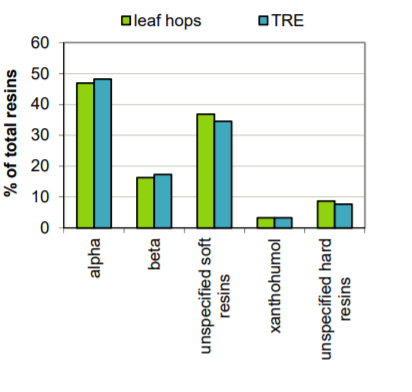Knowde Enhanced TDS
Identification & Functionality
- Flavor
- Flavor Family
- Flavor Ingredient Class
- Ingredient Name
- Food Ingredients Functions
- Ingredients
- Hops, Hop Acids
- Technologies
- Product Families
Features & Benefits
- Benefit Claims
- Food Ingredients Features
- Product Highlights
- Total Resin Extract (TRE) is produced from aroma or bitter hop varieties through extraction with pure alcohol derived from fermentation. TRE contains all of the hop bitter acids (hard and soft resins) and hop oil components of the original leaf hops.
- TRE is added to the kettle and can be used to partially or entirely replace leaf hops, hop pellets or CO2 extract.
- TRE offers a concentrated and practical alternative to leaf hops or hop pellets with an identical bitter. Moreover, TRE has a long shelf life.
Composition of hop resin in leaf hops and TRE

- Product Information
- Appearance
Dark green in color, TRE is a thick syrup/paste that becomes more fluid when warmed.
- Utilization
If TRE is boiled for at least 50 minutes, utilization in the range of 30 – 40 % can be expected. Actual utilization will vary from brewery to brewery due to differences in equipment and process conditions.
• Flavor
The flavor and especially the bitter characteristics of the original hops are completely retained. Early additions of TRE during wort boiling mainly serve to impart bitterness.
• Chemical Residues
Nitrates and heavy metals are significantly lower in TRE. In addition, pesticide residues are largely removed by the ethanol extraction process.
• Quality
All Hopsteiner® products are processed in facilities which fulfill internationally recognized quality standards.
Applications & Uses
- Markets
- Applications
- Food & Nutrition Applications
- Product Use
TRE is typically added to the wort kettle as a complete or partial replacement for leaf hops or hop pellets.
• Dosage
Kettle additions of TRE are based on the concentration of bitter substances (CBV), an estimated or known utilization and the desired intensity of bitterness in the beer.
• Addition
For the highest possible utilization, TRE should be added early in the wort boiling process. TRE is not very suitable for late hop additions due to its nonpolar character. However, in this situation, better results can be achieved with pre-isomerized kettle extracts such as IKE or PIKE, products that are more soluble in wort.
Pre-warming cans of TRE is not necessary. Suspending punctured cans in the boiling wort will ensure that all of the extract is completely flushed out into the kettle.
If TRE is added by means of automatic dosing units, it should be warmed to 45 °C (113 °F) and gently mixed to ensure perfect dosing.
Properties
- Physical Form
- Typical Properties
| Value | Units | Test Method / Conditions | |
| Alpha acids | 20 – 55 | % | — |
| Beta acids | 15 – 30 | % | — |
| Iso-Alpha acids | 0.5 – 2.0 | % | — |
| Hot Oil | approx. 3 – 12 | % | — |
| Residual ethanol | max. 0.3 | % | — |
| pH | 5.7 - 6.8 | — | — |
| Viscosity at 45 °C (113 °F) | 400 – 1000 | mPas | — |
| Density at 20 °C (68 °F) | approx. 1.0 | g/ml | — |
Technical Details & Test Data
- Analytical Methods
• Concentration of Bitter Substances
Iso-alpha, alpha and beta acids can be measured with the current standards using the following methods :
-
- HPLC according to Analytica-EBC 7.8
- ASBC Hops-16
The lead conductance value can be measured using the following methods:
-
- Analytica-EBC 7.6
- ASBC Hops-8 (II)
TRE is normally dosed according to its Conductometric Bitter Value (CBV) as this value better represents its bitterness potential.
Note: CBV = LCV (EBC 7.6) + 50 % of iso-
alpha acids (EBC 7.8)
• Concentration of Hop Oil
The hop oil concentration can be measured using the following methods:
-
- Analytica-EBC 7.10
- ASBC Hops-13
-
- Technical Support
We are pleased to offer assistance and advice on the full range of Hopsteiner® products:
- copies of all relevant analytical procedures
- Safety Data Sheets (SDS)
- assistance with pilot or full-scale brewing trials
- special analytical services
Disclaimer: The information provided in this document is believed to be correct and valid.
However, Hopsteiner® does not guarantee that the information provided here is complete or accurate and thus assumes no liability for any consequences resulting from its application.
Safety & Health
- Safety
TRE is a natural substance and may be safely handled using routine precautions to avoid contact with skin and, in particular, the eyes. Any product coming into contact with the skin should be washed off immediately with soap and water or an appropriate hand cleanser. If TRE gets into the eyes, flush with copious amounts of water until clear and seek medical attention.
Packaging & Availability
- Packaging
TRE can be packaged in cans and drums according to customer requirements:
Cans: 0.5 to 4.2 kg
Drums: 50 and 200 kg
TRE can be produced to any alpha acid concentration desired by our customers and packaged in cans (e.g. 450 g of alpha acids per can).
Alternatively, the alpha acid content of TRE can be standardized to any given concentration using glucose syrup (non- GMO glucose cannot be guaranteed). The container is then filled to a standard weight (e.g. 30 % alpha acids in 1 kg cans).
Storage & Handling
- Storage
TRE should be stored in sealed containers at temperatures < 10 °C (50 °F). Opened containers should be used within a few days.
• Best Before Date
TRE is stable for eight years from the date it was produced / packaged if stored under the recommended conditions.



